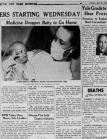Smallest premature infant from 1942 celebrates 75th birthday
Caring for premature and low birth weight infants has significantly changed over the past 75 years. When a nurse practitioner from Hennepin County Medical Center (HCMC) recently met a patient from 1942, these amazing details were brought to life – and are a reminder of the remarkable advances that have been made in premature infant care.
Calvin Lepp was born on January 5, 1942 weighing one and three-quarter pounds. At the time, he was Minneapolis General Hospital’s smallest surviving premature infant. A local newspaper learned of Lepp, covered his progress while he was hospitalized, and then ran a feature story about him when he was finally discharged in May of that year.
“I don’t remember much of it,” jokes Lepp, “but they tell me it was a miracle surviving as  small as I was. The odds were against me, but I turned out just fine. Got over that weight problem real quick.”
small as I was. The odds were against me, but I turned out just fine. Got over that weight problem real quick.”
Lepp is a regular at Eden Prairie’s Tavern 4&5, where he met HCMC Neonatal Nurse Practitioner Kolleen Amon, who works in the newborn intensive care unit (NICU).
“Cal is such a character at the tavern – he even has his own spot with his ‘Cal’s Corner’ street sign,” Amon explains. One evening, Lepp was talking to Amon about his wife who passed away from breast cancer. He mentioned how amazing the nurses were who took care of her.
“I told him I was a Nurse Practitioner in HCMC’s NICU, and to my surprise he shared that he was the smallest baby ever saved by HCMC, which of course was Minneapolis General Hospital back in 1942.”

Original newspaper clipping of “Medicine Dropper Baby” from 1942 (Photo courtesy of Star Tribune)
Lepp brought in a copy of the newspaper article from that year which included a photo of him with his nurse on the day he was discharged. The article summarized some of the unique aspects of his care. Amon and her NICU colleagues were intrigued to learn about the standard interventions used to save Lepp’s life – even though they are no longer used today. At the time they were considered “best practices,” and Minneapolis General Hospital already had a reputation for having one of the lowest newborn mortality rates in the country.
Some examples include of Lepp’s care included:
Formula feedings via a medicine dropper
For weeks, Lepp was given formula feedings from a medicine dropper. Today, preterm babies are fed breast milk through an indwelling tube inserted in the mouth or nose down to the stomach. In addition, the article states that “Lepp received only one-sixth of an ounce of breast milk for weeks.” HCMC strongly supports the use of breast milk for preterm infants with lactation services for all mothers to provide breast milk and to breast feed at discharge. With what we know today, receiving mother’s milk may have been the most important factor in Cal’s survival.
Life in an oxygen tent
Studies now show that oxygen in high doses can be harmful to babies. Lepp had vision issues from receiving too much oxygen – but that was the standard of care for premature infants in 1942. We now have state-of-the-art isolettes that allow ambient oxygen to flow through the isolette. We have the ability to give oxygen directly to the baby through respiratory support devices and protocols in place to determine the correct amount of oxygen to deliver to a baby based on their needs.
Frequent administration of respiratory and cardiac stimulants
A “dozen times” General Hospital physicians all but gave (Lepp) up. His tiny body actually “turned black” on these occasions. Now, with artificial surfactant to prepare lungs for the world, we are able to prevent many of respiratory problems that are caused from prematurity and ventilation support. Now we use caffeine – the same thing in coffee – to help prevent preterm babies from stopping breathing.
“It is amazing he survived,” explains Dr. Connie Adkisson, medical director of HCMC’s NICU. “But 75 years from now someone may read an article about our standards of care and wonder the same thing.”
So what about the future of premature infant care?
“Antibiotic stewardship comes to mind,” says Dr. Adkisson. “At HCMC, we are already implementing procedures to reduce the amount of antibiotics given to premature and term babies because research has shown that excessive use of antibiotics can increase childhood asthma, lead to antibiotic resistance, and allows growth of less healthy bacteria in the baby’s gastrointestinal tract.”
HCMC NICU “graduates” of all ages and their families are invited to a 75th birthday party for Cal Lepp at HCMC on Wednesday, January 25 from 2-4 PM. A historical look at the advances in premature care, as well as activities and refreshments will also mark the occasion.
Strategically located next to HCMC’s Birth Center, our 21-bed Newborn Intensive Care Unit (NICU) has a comprehensive team of specialists available around the clock to care for infants who need intensive care.
Read the Star Tribune article from January 25, 2017.

